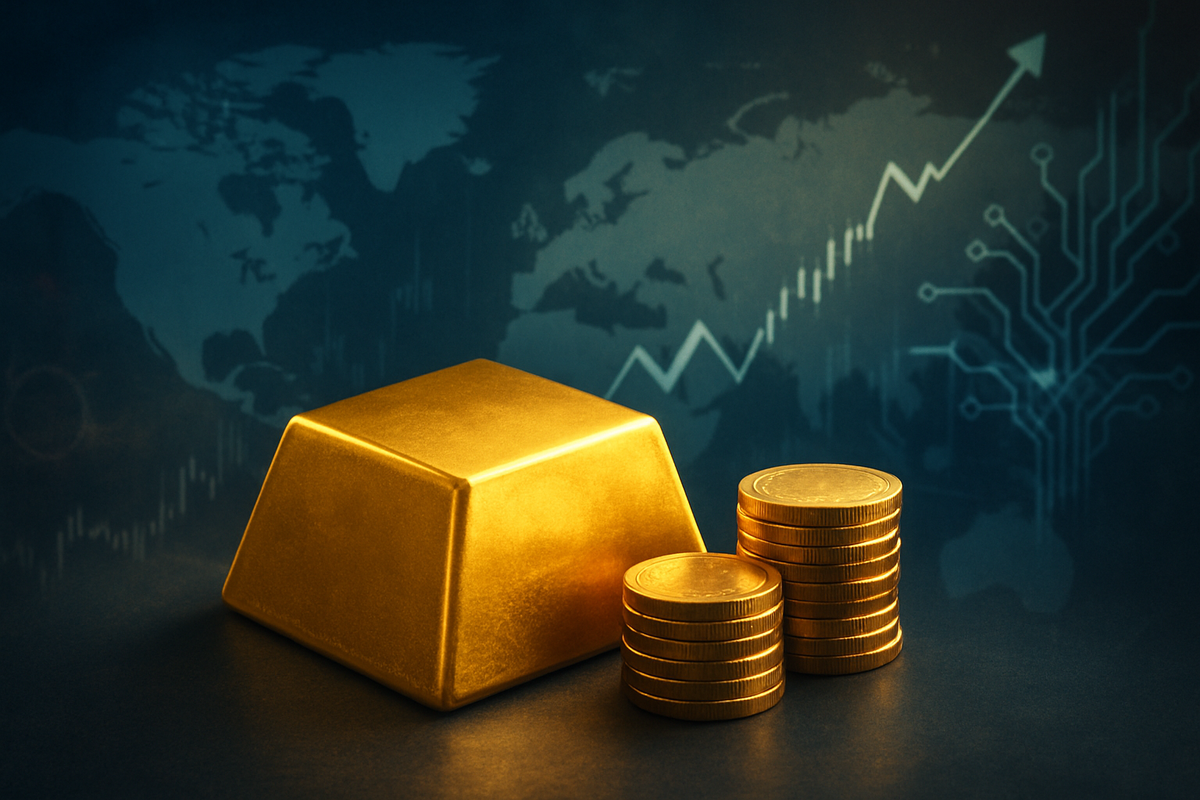
London, UK – October 8, 2025 – Gold prices experienced a significant surge of over 1% on Wednesday, pushing the precious metal further past the $4,000 per ounce mark, driven by a confluence of persistent economic anxieties and escalating geopolitical uncertainties. This robust performance by gold occurred even as U.S. stock markets largely traded higher, with the tech-heavy Nasdaq Composite gaining more than 100 points and the S&P 500 reaching new all-time highs, largely fueled by an ongoing frenzy around artificial intelligence technology. The simultaneous rise of both traditional safe-haven assets and growth stocks highlights a complex and often contradictory market landscape, where investors are hedging against global instability while simultaneously chasing high-growth opportunities.
The day's trading saw gold spot prices climb 1.2% in early London trading, settling at $4,031.54 per ounce by 8 am. This upward movement reflects a broader trend that has seen gold appreciate by over 50% year-to-date in 2025, cementing its status in a robust bull market. On the equity front, the S&P 500 (NYSE: SPX) rose 0.6%, marking its latest record close, while the Nasdaq Composite (NASDAQ: IXIC) advanced 1.1% to achieve its own historic peak. In contrast, the Dow Jones Industrial Average (NYSE: DJI) registered a marginal decline of less than 0.1%. This divergence underscores a market grappling with a blend of speculative enthusiasm and deep-seated caution.
Detailed Market Dynamics and Influencing Factors
Wednesday, October 8, 2025, unfolded against a backdrop of specific domestic and international pressures that directly impacted market sentiment. The ongoing U.S. government shutdown played a significant role, contributing to market uncertainty by delaying the release of crucial economic reports. This informational vacuum often prompts investors to seek the perceived safety of assets like gold, which traditionally acts as a hedge against economic instability.
Beyond the immediate domestic concerns, underlying inflation worries and the increasing burden of national debt across major economies, including the U.S., continued to fuel demand for gold. Investors view the precious metal as a reliable store of value capable of preserving purchasing power in an environment of currency debasement and rising prices. Furthermore, expectations of continued monetary easing by the Federal Reserve, following a 50 basis point rate reduction in September 2024, made non-yielding assets like gold more attractive by reducing the opportunity cost of holding them.
Geopolitical factors also cast a long shadow over the markets, significantly contributing to gold's allure. General global political and economic uncertainty, exacerbated by specific political instability in regions like France and Japan, pushed investors towards safe-haven assets. The lingering effects of trade policies, particularly the tariffs introduced by U.S. President Donald Trump since April, continued to spark fears of global trade disruptions, further bolstering gold's appeal. Additionally, ongoing global conflicts, notably in the Middle East and Ukraine, have provided consistent upward pressure on gold prices throughout 2023-2025, underscoring its role as a hedge against geopolitical risk.
While gold benefited from these anxieties, U.S. equities, particularly in the technology sector, rode a wave of optimism driven by advancements in artificial intelligence. This "AI frenzy" propelled several companies to significant gains, illustrating a market capable of simultaneously rewarding innovation and seeking refuge from uncertainty.
Corporate Beneficiaries and Market Implications
The day's market movements created clear winners, particularly within the technology sector, while also highlighting the enduring appeal of gold-related assets. Companies deeply entrenched in the AI revolution saw substantial gains, reinforcing the narrative of technology as a primary growth driver.
Advanced Micro Devices (NASDAQ: AMD), a semiconductor giant, saw its shares jump an impressive 11.4% on Wednesday. This surge extended its rally from earlier in the week, following an announcement of a significant AI-related deal, positioning it as the best-performing stock in the S&P 500 (NYSE: SPX) for the day. Similarly, Dell Technologies (NYSE: DELL) experienced a 9.1% rise in its stock, building on previous gains after the company discussed its burgeoning growth opportunities directly linked to AI. Another notable performer was Poet Technologies (TSXV: PTK), which climbed 17% after announcing it had secured $75 million in investment to accelerate its development of high-speed optical engines crucial for AI systems. These companies exemplify the intense investor appetite for firms at the forefront of AI innovation.
On the other side of the spectrum, gold mining companies and exchange-traded funds (ETFs) linked to gold, while not explicitly detailed in the day's company news, would undoubtedly benefit from the surge in gold prices. Higher gold prices typically translate to improved profitability for miners and increased asset values for gold-backed investments. While no explicit "losers" were identified, companies outside the AI boom or those heavily exposed to geopolitical instability or inflation without adequate hedging strategies might find themselves struggling to attract investor interest in such a bifurcated market environment. The ongoing U.S. government shutdown, for instance, could negatively impact government contractors or industries reliant on regulatory approvals.
Wider Significance and Historical Context
The simultaneous ascent of gold and U.S. equities on October 8, 2025, is more than a fleeting market anomaly; it signifies a deeper shift in global financial dynamics. This event fits into a broader trend of gold's increasing decoupling from traditional market correlations. Historically, gold often moved inversely to stocks, acting as a countercyclical asset. However, the current environment, characterized by persistent inflation concerns, massive government debt, and pervasive geopolitical instability, has seen gold flourish even when equities perform well, driven by both debasement concerns and safe-haven demand.
This robust bull market for gold, which has seen prices surpass $3,000/oz by March 2025 and continue its ascent, is also heavily influenced by unprecedented central bank purchases. Central banks globally, particularly those of China, India, Russia, and Turkey, have been accumulating gold at record levels, diversifying their reserves away from the U.S. dollar due to sanctions risks and shifting geopolitical alliances. This "dedollarization" trend removes significant supply from the market, creating a structural demand imbalance that supports higher gold prices.
The AI frenzy in the stock market, epitomized by the performance of companies like AMD, Dell, and Poet Technologies, represents another powerful, albeit distinct, trend. This technological revolution is reshaping industries and driving massive capital allocation into innovative sectors. The ripple effects extend to competitors, who must either innovate or risk being left behind, and partners, who may find new collaborative opportunities or face disruption. Regulatory bodies are also grappling with the implications of rapidly advancing AI, with potential policy implications for data privacy, market competition, and ethical use. Historically, periods of rapid technological advancement have often coincided with shifts in global power and economic paradigms, much like the dot-com boom of the late 1990s, though the current AI wave appears to be more fundamentally integrated into various sectors.
What Comes Next: Navigating a Complex Future
Looking ahead, the financial markets are poised for continued complexity, driven by the interplay of these powerful economic and geopolitical forces. In the short term, the resolution of the U.S. government shutdown will be a critical watch point, as it will likely release delayed economic data and potentially stabilize some market uncertainties. Geopolitical developments, particularly in ongoing conflicts and trade relations, will continue to exert significant influence on safe-haven demand for gold. Simultaneously, the momentum around AI technology is expected to persist, leading to further volatility and potentially new breakthroughs that could reshape market leadership.
In the long term, the trajectory of gold prices will heavily depend on how governments address large debt loads and inflation, as well as the evolution of central bank monetary policies. A sustained environment of low real interest rates and currency debasement would likely continue to support gold's rally. For the stock market, the AI revolution presents both immense opportunities and potential challenges. Companies that can effectively integrate AI into their operations and product offerings stand to gain significantly, while those lagging in adoption may face increasing competitive pressure.
Potential strategic pivots for investors and corporations will involve a dual focus: maintaining exposure to high-growth, innovative sectors like AI while simultaneously hedging against macroeconomic and geopolitical risks through assets like gold. Market opportunities may emerge in niche AI applications, new energy solutions, and diversified commodities. Challenges will include managing heightened market volatility, navigating complex international relations, and adapting to potential regulatory changes in the tech sector. Possible scenarios range from a "goldilocks" environment where AI innovation drives growth without triggering runaway inflation, to a more challenging landscape marked by stagflation and heightened global tensions, where gold's role as a safe haven becomes even more pronounced.
Comprehensive Wrap-up and Investor Outlook
The events of October 8, 2025, serve as a potent illustration of the intricate and often paradoxical nature of contemporary financial markets. The day's trading underscored several key takeaways: gold's enduring role as both an inflation hedge and a safe-haven asset in an era of unprecedented uncertainty, and the undeniable dominance of artificial intelligence as a primary driver of equity market gains. This dynamic suggests a market moving forward with a bifurcated character, where technological innovation and safe-haven demand coexist and often thrive independently.
For investors, understanding this complex interplay is paramount. The market is no longer solely driven by traditional correlations; instead, it is shaped by a confluence of monetary policy shifts, geopolitical flashpoints, and transformative technological advancements. The lasting impact of these trends could be a new paradigm where diversification strategies must account for both speculative growth and robust risk mitigation.
In the coming months, investors should closely monitor several critical indicators. Geopolitical developments, particularly in regions of conflict and in the arena of international trade, will continue to dictate safe-haven flows. Central bank policies, especially regarding interest rates and quantitative easing, will influence the opportunity cost of holding gold and the broader economic outlook. Inflation data, coupled with government debt trajectories, will remain crucial for assessing gold's long-term appeal. Finally, continued innovation and earnings reports from the technology sector, particularly those related to AI, will provide insights into the sustainability and breadth of the current tech rally. Navigating this environment will require agility, a diversified approach, and a keen awareness of both the risks and opportunities presented by a rapidly evolving global landscape.
This content is intended for informational purposes only and is not financial advice





